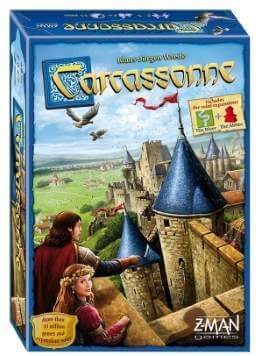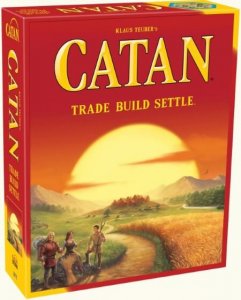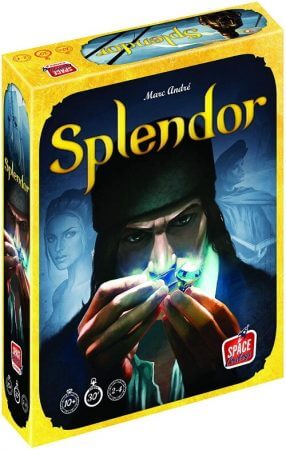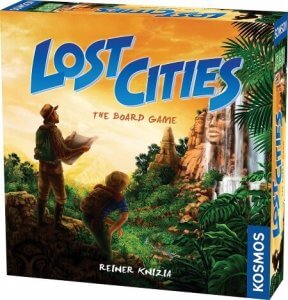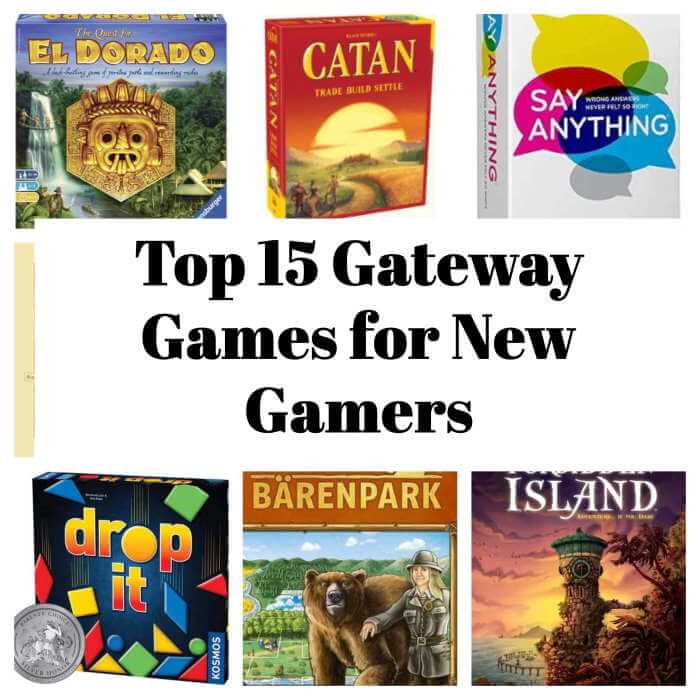
Deciding which game to bring to a game night with family and friends who don’t typically play many board games, or who have never been introduced to a modern designer board game, can be challenging.
After all, there are many aspects to consider to ensure that the gaming experience is positive, such as the nature of the game night, personality types of other players, and ideal game length.
Whether you are looking to introduce someone to the hobby for the first time, or you are new to the hobby yourself and are exploring good games to check out, here is a list of 15 gateway games that are excellent choices depending on your situation or preferences.
1. Ticket to Ride – Best Route-Building Game
The award-winning classic board game Ticket to Ride, designed by Alan R. Moon, hardly needs an introduction as it is one of the most well-known gateway board games of all time; having won the Spiel des Jahres and sold millions of copies since it was released in 2004, there is no question it has become a staple in many families’ game collections.
The award-winning classic board game Ticket to Ride, designed by Alan R. Moon, hardly needs an introduction as it is one of the most well-known gateway board games of all time.
Because it is a tried-and-tested game to play with friends and family members who have never played designer board games, it would be a shame to leave it off this list.
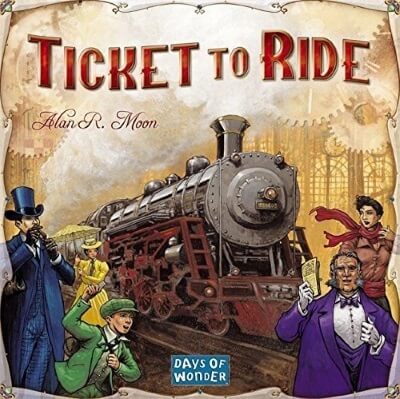
Ticket to Ride at a Glance
| Game Type Train Theme, Card Drafting, Network and Route Building | Play Time 60 mins | Skill/Complexity (2 - 5) Light to Medium |
| Age 8+ | Publisher(s) Days of Wonder | Published 2004 |
| Categories Family / Strategy | Players 2 - 5 | Rules Manual Official Rules PDF |
| Our Rating 9/10 | Cost $49.99 |
The standard version of Ticket to Ride features a map of the United States, and in the game, players compete to fill the board with train tokens of their color in order to score the most points by building routes and fulfilling destination tickets. The game has a set-collection element as players attempt to acquire the necessary colors to complete critical routes on the board, and a clear route-building aspect as players work to connect cities from their destination tickets.
What makes Ticket to Ride the best route-building gateway game for this list is the fact that the game concepts and objectives are very easy to teach to non-gamers for a few reasons. First, the objective of the game is very clear and easy to comprehend; players earn points at the end of the game for completing route cards and completing routes on the board. Second, the three choices available on a player’s turn are simple and intuitive; draw cards, build a route, or draw additional destination tickets. Third, the game is a lot of fun, and it’s easy to get new players to appreciate the challenge of completing routes while competing with other players for spots on the board (and potentially blocking routes on purpose).
2. Forbidden Island – Best Cooperative Game
In a quest for treasure on an ancient mystical island, players in Forbidden Island work together to collect items and treasure before time runs out – the island is sinking and you must do what it takes to remain afloat and keep a path to escape open.
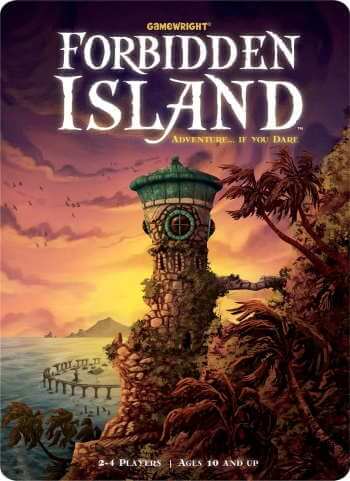
Forbidden Island at a Glance
| Game Type Fantasy, Adventure, Action Points, Cooperative, Grid Movement, Map Reduction, Modular Board Pick-up and Deliver, Solo/Solitaire Game Variable Player Powers | Play Time 30 mins | Skill/Complexity (2 - 5) Light |
| Age 10+ | Publisher(s) Gamewright and Others | Published 2010 |
| Categories Family | Players 1 - 4 | Cost $19.99 approx |
| Our Rating 8/10 |
Forbidden Island, designed by Matt Leacock, is a fully cooperative game in which players will either win or lose as a group.
To win, players must discover and collect all four treasures on the island, and escape via the helicopter pad before any player’s route is closed off. Each player takes on the role of a unique adventurer at the beginning of the game, each of which grants special abilities that break the standard rules of the game. On their turn, players take up to three actions – moving, shoring up an island tile, giving a treasure card to another player on the same tile, or capturing a treasure by discarding four identical treasure cards. Flood cards, which must be drawn at the end of a player’s turn, flood specific location tiles on the board. If a player reveals a flood card for a tile that is currently flooded, it is permanently removed from the game.
Forbidden Island has made this list for best cooperative gateway game because it is especially easy to teach, with a theme appropriate for any age group, and a visually-stunning table presence. There is hardly anything intimidating about this game for someone who has never played a hobby board game before, especially because there is no secret information and players are working together to achieve the same goal.
Forbidden Island has made this list for best cooperative gateway game because it is especially easy to teach.
As an added bonus, Forbidden Island can typically be found for a very low price point, making for a great gift to friends and family members.
3. Carcassonne – Best Tile-Placement Game
Pulling tiles out of a bag, placing them on a table, building a map, and placing the iconic wooden meeples – what could be more enjoyable and relaxing than a round of Carcassonne?
While it’s hard to believe that Carcassonne is now 20 years old, it has certainly proved the test of time as an excellent family-weight entry into the world of board gaming.
While it’s hard to believe that Carcassonne is now 20 years old, it has certainly proved the test of time as an excellent family-weight entry into the world of board gaming.
Carcassonne at a Glance
| Game Type Tile Placement City and Territory Building Medieval Theme | Play Time 45 mins | Skill/Complexity (2 - 5) Light |
| Age 8+ | Publisher(s) Hans im Glück and others | Published 2000 |
| Categories Family / 2 Player | Players 2 - 5 | Rules Manual Official Rules PDF |
| Our Rating 9.5/10 | Cost $24.99 + |
Carcassonne, the 2001 Spiel des Jahres award-winning game designed by Klaus-Jürgen Wrede, is a board game that starts with no board on the table (unless you count the score track). Instead, players build the board over the course of the game by drawing tiles and placing them accordingly to match with adjacent terrain. Players have the option to place a meeple – a universal board gaming term born from this very game – in order to claim a city, road, monastery, or field, each of which will gain them points once completed or at the end of the game.
While Carcassonne is a competitive game, there is a sense of collective achievement at the end of the game with a large and unique sprawling map on the table that didn’t exist at the beginning of the game. This is part of what makes Carcassonne perfect for this list as best tile-placement gateway game: its satisfying sense of accomplishment that makes players eager to play again. What also makes Carcassonne a wonderful gateway game is the fact that players don’t necessarily need to know every single rule before their first turn.
It’s fairly easy just to walk each player through their options with each tile they draw, until they grasp all the available options/strategies after a few turns. It won’t take players long to realize that the game is full of interesting choices and hidden layers of competition. For instance, will they try to build a huge city and risk someone else coming in to steal it, or will they just complete a bunch of small cities? Carcassonne is a blast to teach, and a great candidate for this list for these reasons.
4. Catan – Best Resource-Management Game
When many people think of the term “gateway game,” one of the most common games that comes to mind – and indeed a game that managed to get most of us hobby gamers into the hobby – is Catan (formerly Settlers of Catan).
Believe it or not, but this game was published back in 1995, and won the Spiel des Jahres award that year. Yet, it still remains extremely popular and can be found in just about any store that sells games to this day.
Catan at a Glance
| Game Type Medieval Theme, Dice Rolling, Negotiating, Card Game Hexagon Grid, Building Settlements | Play Time 60 - 120 mins | Skill/Complexity (2.8 - 5) Light - Medium |
| Age 10+ | Publisher(s) Kosmos, Catan Studio and others | Published 1995 |
| Categories Family / Strategy | Players 3 - 4 | Rules Manual Official Rules |
| Our Rating 9.5/10 | Cost $48.99 |
The goal in Catan is to be the first player to gain at least 10 VPs on your turn by building towns, cities, roads, and playing development cards. The game is, at its core, a resource management game as players continually gain resources when they, or another player, roll a die value that equals the value associated with one of their regions. In order to progress in the game and build structures or buy development cards, players must pay resource costs. Because it’s very challenging to gain all necessary resources by their own means, players must typically engage in negotiations with other players to trade resources.
This negotiation element is certainly one aspect that makes Catan such a good gateway game, and the best resource-management game for this list.
This negotiation element is certainly one aspect that makes Catan such a good gateway game, and the best resource-management game for this list.
For someone who has never played a hobby board game before, the idea of being able to wheel and deal with other players at the table in exchange for resources or “promised” favors can feel both unique and exhilarating. It’s easy for new players to have fun at this game, and because there is a blend of luck and strategy, it can be less punishing for players who have never played before.
If you’re a fan of Catan then you might like to check out our Top 10 Board Games Like Catan
5. Say Anything – Best Party Game
There are many extremely popular party games out there these days, but one of the most popular games to find at a party is easily either Cards Against Humanity, or a game with a slightly different spin on the same idea.
While there are more and more party games emerging in the hobby board gaming space – such as Codenames and Just One – if you are looking for a party game to bring to a gathering with friends who repeatedly play standard “judge picks their favorite card” games, then Say Anything is a great selection for this genre.
If you are looking for a party game to bring to a gathering with friends who repeatedly play standard “judge picks their favorite card” games, then Say Anything is a great selection.
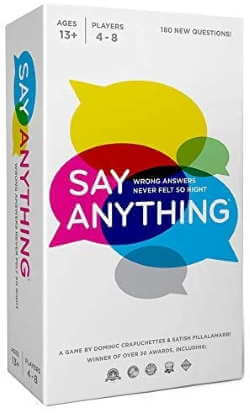
Say Anything at a Glance
| Game Type Humor, Betting and Bluffing, Paper-and-Pencil, Player Judge | Play Time 30 mins | Skill/Complexity (1 - 5) Light |
| Age 13+ | Publisher(s) North Star Games | Published 2008 |
| Categories Party / Family | Players 3 - 8 | Cost $19.95 approx |
| Our Rating 8.1/10 |
While Say Anything shares the same core concept as these judge-style party games, what sets this game apart is that players are not limited to a hand of cards to use their imagination.
In Say Anything, a judge asks a question from a card they draw, and then each player writes an answer on dry erase board of their color, and puts its face up in the middle of the table. Once all players have submitted a response, the judge secretly selects on a player dial the player whose response they most like, and then they place their dial face down. The players then each have two voting tokens, and they can cast two votes for the answer they think the judge picked as their favorite (they can put two tokens on one player’s board, or divide it between two; they can also vote on their own board). The judge then reveals their pick, and players receive points: the judge gets one point for each voting token on the player board they selected (max of 3 points), players get one point for each voting token they placed on the player board the judge selected, and the player whose answer the judge selected gets 1 point.
The game is over once players have had a chance to play the role of the judge a certain amount of time depending on the number of players.
If you’ve ever been to social gatherings where friends insist on playing the same party games time and time again, and you are looking to shake things up and introduce something with a little more creativity and decisions to make, then Say Anything is a good selection for this purpose.
Say Anything is fun, hilarious, and will likely leave your friends asking where you discovered this game.
6. The Quest for El Dorado – Best Deckbuilding Game
Racing through jungles and crossing rivers to be the first explorer to reach the legendary city of El Dorado, players in The Quest for El Dorado must be smart in who they hire to lead their expedition and the items they acquire if they wish to be efficient in their voyage.
While most people think of Dominion as the go-to gateway deckbuilding game, The Quest for El Dorado the 2017 Spiel des Jahres nominee designed by Reiner Knizia, is making this list in this genre for a couple of reasons explained below.
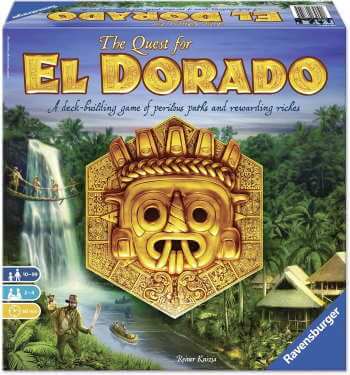
The Quest for El Dorado at a Glance
| Game Type Adventure, Card Drafting, Deck Building, Hexagon Grid, Modular Board, Racing | Play Time 30 - 60 mins | Skill/Complexity (2 - 5) Light |
| Age 10+ | Publisher(s) Ravensburger | Published 2017 |
| Categories Family | Players 2 - 4 | Cost $45.95 approx |
| Our Rating 9/10 |
In The Quest for El Dorado, players take turns playing cards from their hand to traverse various types of terrain on the game board, buying a card from the available display, discarding played cards, and then drawing back up to a hand of four. The first player to make it to the end of the city of El Dorado first is the winner.
A unique aspect of the game is the fact that the available card market consists of six piles of identical card types. If, on a player’s turn, there is an empty slot of cards in the available market, they can choose to buy a card not currently in the market; that card’s pile is then moved to fill the empty space in the market, making it available to other players on future turns. As is typical in deckbuilding games, cards with a higher cost will allow a player to perform more powerful turns, and there are ways to cull less-powerful cards from a player’s deck in order to make a more efficient deck.
What makes The Quest for El Dorado a wonderful gateway deckbuilding game is the fact that, for players who are new to modern board games – and especially those who have never played a deckbuilding game before – this is a very easy game to teach the concept of this mechanism.
Those who have never played a deckbuilding game before – this is a very easy game to teach the concept of this mechanism.
First, the winning conditions are ultra-clear: be the first to reach the city. New players can easily understand the goal of a racing game, and there is no need to watch eyes glaze over as you attempt to explain multiple avenues to score VPs. Second, it’s easy for new players to grasp how each card helps to achieve their goal of getting to the finish line. Because the game has a physical board, players can more easily visualize and strategize the types of cards they will need to be successful. If they draw a hand of cards that doesn’t help them well on that turn, they will usually understand that they need to find a way to get those cards so that they can advance, or find an alternate route.
If you are looking for a gateway game that offers competitive play and simple-to-grasp rules within the deckbuilding genre, then this is definitely a game to consider.
7. Drop It – Best Dexterity Game
Everyone has memories of playing games like Connect Four and Jenga growing up, and if you are tired of having to play these games at family gatherings and are looking for something a bit more modern that just about anyone will still very much enjoy, look no further than Drop It.
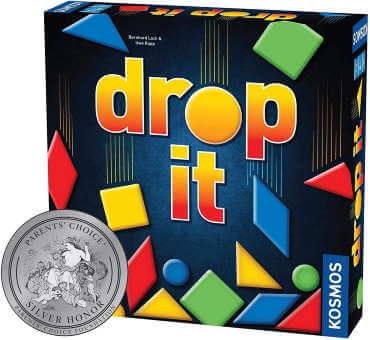
Drop It at a Glance
| Game Type Action/Dexterity | Play Time 30 mins | Skill/Complexity (1.2 - 5) Light |
| Age 8+ | Publisher(s) KOSMOS | Published 2018 |
| Categories Family | Players 2 - 4 | Cost $29.95 approx |
| Our Rating 8/10 |
Drop It is a dexterity-style game designed by Bernhard Lach and Uwe Rapp that features a large plastic stand where players take turns dropping wooden shapes of their color into the top. Depending on how they manage to make their pieces land, players score points in attempt to gain the most points by the end of the game. A player will not get any points if their shape touches another shape of either the same color or shape, or if it touches a border and breaks the rules indicated on that area. A player gains points depending on the region where their shape lands, and additional bonus points if it’s touching a bonus circle printed on the outside of the tower. The game ends once players have placed all of their shapes, and whoever has the most points is the winner.
Drop It is an ideal gateway dexterity game in the sense that it feels familiar to new players as a game they could have grown up with, but has just enough going on, in terms of points and variable setups included in the box, to keep the game interesting over multiple plays for seasoned gamers.
Drop It is an ideal gateway dexterity game in the sense that it feels familiar to new players as a game they could have grown up with.
The rules of Drop It could easily be explained in less than a couple minutes, and lends itself well to high energy and engaging game play. Players are very likely to have a very good time with this game, and if you are looking to introduce them to slightly more complex games, this could be a good entry point.
8. Azul – Best Abstract Strategy Game
You’ve been tasked by the king of Portugal to piece together a beautiful wall within the royal palace, in style of the Moorish walls of the Alhambra in Andalucia. To do so, you will need to complete your wall with azulejo tiles in an appealing way, and collect the most points to prove that you are a true master of your craft.
With a beautiful table presence featuring colorful tiles and bright player boards, Azul, the 2018 Spiel des Jahres winner designed by Michael Kiesling, is an abstract game that is both a pleasure to gaze upon and a simple game to teach to new players – making it an excellent candidate for this list.
An abstract game that is both a pleasure to gaze upon and a simple game to teach to new players – making it an excellent candidate for this list.
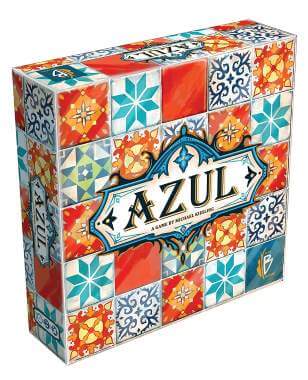
Azul at a Glance
| Game Type Renaissance Theme Abstract Card Drafting Pattern Building Tile Placement | Play Time 30 - 45 mins | Skill/Complexity (2.5 - 5) Good Medium - Light Abstract Strategy |
| Age 8+ | Publisher(s) Plan B Games and Others | Published 2017 |
| Categories Family / Teens / Abstract Strategy | Players 2 - 4 | Manual EN-Azul-Rules PDF |
| Our Rating 9.5/10 | Cost Approx $29.99 |
In a round of Azul, players take turns drafting tiles from the center of the table and placing them in their pattern lines on their board, to be potentially placed onto their wall at the end of the round. On a player’s turn, they either take all the tiles of one color from any factory (circle) in the middle of the table, or take all the tiles of one color from the center of the table. Once a player takes tiles of one color from a factory, the remaining tiles slide into the middle of the table. Pattern lines on a player’s board can only contain tiles of one color, and if that line is full at the end of the round, the player moves the rightmost tile onto the corresponding place on their wall (a 5×5 grid) and discards the rest. Starting with the top pattern line and moving down, players at the end of the round move eligible tiles onto their wall and score points for each tile that is both horizontally and vertically linked to that tile (including the tile itself). The first player to complete a full horizontal row triggers the end of the game, and players gain bonus points for each horizontal and vertical row, and for each set of completed colors on their wall. The player with the most points wins.
The turn structure and choices a player can make on their turn are intuitive concepts to teach to new players, and while the scoring aspect of Azul can be a little tricky to explain to new players, after just one round of the game it is usually clear how everything works together.
What makes Azul a brilliant gateway abstract strategy game is the fact that it is visually stunning, and has a very simple rhythm that makes it easy for new players to get the hang of relatively quick. The game offers a good amount of depth in terms of thinking ahead several turns, and is a game that people will likely want to play again after their first play.
9. Splendor – Best Set Collection Game
As a rich merchant in the Renaissance, do you have what it takes to turn your gems – emeralds, diamonds, sapphires, onyx, and rubies – into jewels and gain visits from nobles in order to score the most VPs?
While the theme of this game is not well-known for being particularly strong, Splendor, the 2014 Spiel des Jahres nominee designed by Marc André, is certainly one that is quick, fun, and engaging for new gamers, and one to consider for your next game night with family or friends.
Splendor at a Glance
| Game Type Card Game, Economic, Renaissance, Card Drafting, Turn-Based, Resource Management | Play Time 30 mins | Skill/Complexity (2 - 5) Light - Medium |
| Age 10+ | Publisher(s) Space Cowboys and others | Published 2014 |
| Categories Family | Players 2 - 4 | Cost $30 - $40 |
| Our Rating 9/10 |
Splendor is all about collecting sets of development cards in order to race to 15 points. A player’s turn in in the game is incredibly straight forward: take gems, purchase a card, or reserve a card (and gain 1 gold). A player can either take two gems of the same type if there are at least four gems left in the stack after they take them, or three gems of different types. If a player decides to buy a development card, they pay its cost in gems as indicated on the card, and it goes into their permanent display. Development cards can provide VPs, and also serve as an ongoing bonus for the type of gem listed at the top. On future turns, players can use permanent gems from their development cards, rather than from their gem pool, as discounts for purchasing development cards. They can also reserve a card to play on a future turn, taking it from the display and keeping it face-down in their area, and also gain one gold (a wild resource) for doing so. Moreover, if they meet the requirement indicated on a noble tile at the end of their turn, then they gain that noble tile into their play area and receive its indicated number of VPs. Once a player reaches 15 VPs, remaining players perform their final turn, and whoever has the most VPs is the winner of the game.
There are a couple of aspects of Splendor that make it a good set collection gateway game: its sense of progression it provides players as they collect development cards, and the satisfying tactile feel of the gem tiles. As players gain development cards into their play area, their ability to purchase future cards of that color becomes easier, so while at the beginning of the game it can take a few turns to build up to a development card purchase, toward the end of the game players can more easily purchase the expensive and valuable cards from the top row.
There are a couple of aspects of Splendor that make it a good set collection gateway game: its sense of progression it provides players as they collect development cards, and the satisfying tactile feel of the gem tiles.
A game of Splendor picks up its pace quick, and keeps players engaged through their final turn as they try to purchase the right cards to get them points to win the game. As an added bonus, the poker chip gem tiles provide a sense of satisfaction to pick up, hold in your hand, and set down on the table.
While it’s merely a cosmetic feature of Splendor, the component quality helps to make it a memorable experience for new players.
10. Sheriff of Nottingham – Best Bluffing Game
What could be more fun than lying to your friends, being clever, and trying to sneak contraband past the Sheriff of Nottingham in order to make a profit?
In a game where lying and mistrust, while not technically necessary, is strongly encouraged, Sheriff of Nottingham is a game that can provide a good deal of laughter and inside jokes that will liven up your night with family and friends.
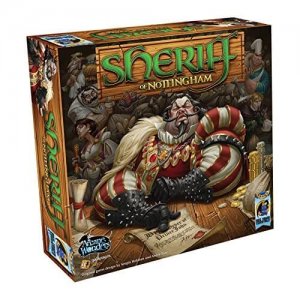
Sheriff of Nottingham at a Glance
| Game Type Medieval Theme Humor, Card Game Bluffing, Card Drafting, Negotiation | Play Time 60 mins | Skill/Complexity (2 - 5) Light |
| Age 14+ | Publisher(s) Arcane Wonders | Published 2014 |
| Categories Kids Game / Family Party | Players 3 - 5 | Rules Manual Official Rules PDF |
| Our Rating 9/10 | Cost $24.99 approx |
In Sheriff of Nottingham, a designed by Sérgio Halaban and André Zatz, players take on the role of merchants trying to make the most profit by bringing legal goods (apples, bread, cheese, and chickens), as well as illegal contraband, through the city gates. At the end of the game, players gain points for the value of their legal goods and contraband, as well as bonus points if they had the most or second most of any category of legal goods.
Each round, one player is the sheriff, and the rest of the players are merchants (each player will be the sheriff twice in a 4-5 player game, or three times in a 3-player game). The merchants load goods cards into their pouch, and then take turns declaring their goods to the sheriff (they always declare one type of legal good, and can never lie about the amount of goods in their bag). The sheriff will then decide whose bags to inspect, and who to let through – often accepting bribes from merchants to either not open their bag, or to open others! If the sheriff inspects a bag and was telling the truth, the sheriff must pay the merchant gold equal to the penalty listed on the cards. If the merchant was lying, they have to discard the cards they were lying about, and then pay the sheriff the penalties listed on the cards.
If you have a group of family or friends who don’t typically play a lot of games, and who you think could get into the theme and bluffing, then Sheriff of Nottingham could be a good fit for you.
If you have a group of family or friends who don’t typically play a lot of games, and who you think could get into the theme and bluffing, then Sheriff of Nottingham could be a good fit for you.
The games rules are very simple to understand, and what makes the game unique within the bluffing game genre is the fact that it doesn’t require you to lie; you can technically play the entire game without lying once. It’s ultimately up to the players how they wish to play the game, and so the game can have a different feel depending on who you play with.
The sheer amount of fun to be had with this game makes Sheriff of Nottingham a great addition to this list of best gateway games.
11. Letter Tycoon – Best Word Game
Sometimes the best gateway games are the ones that remind players of a better version of a game they enjoyed playing growing up. It can lead to the question, “If this game is so good, what other board games are out there?” The game we are talking about here is Letter Tycoon, a word game designed by Brad Brooks that will remind people of Scrabble, but one that is almost guaranteed to provide more fun.
A word game designed by Brad Brooks that will remind people of Scrabble, but one that is almost guaranteed to provide more fun.
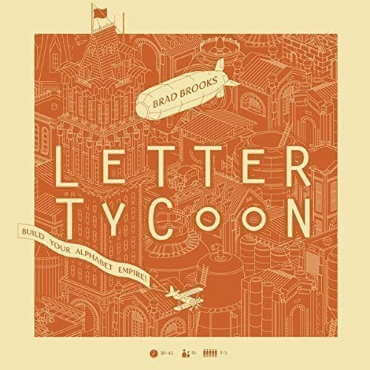
Letter Tycoon at a Glance
| Game Type Word Skills, Commodity Speculation, Set Collection, Variable Player Powers | Play Time 30 mins + | Skill/Complexity (2.3 - 5) Light - Medium |
| Age 8+ | Publisher(s) Breaking Games | Published 2015 |
| Categories Family / Word | Players 2 - 5 | Cost $49.99 |
| Our Rating 9/10 |
On a player’s turn in Letter Tycoon, they attempt to form a word using a combination of the seven letter cards from their hand, and the three cards from the public area – a pretty standard concept. But where the game really stands out in its originality as a word game is that, based on the length of the word they create, players gain a certain amount of money which they can use to purchase an available patent for any letter in their word. Patents provide passive income to its owner any time another uses that letter in a word. Some patents also provide ongoing abilities to players, but are letters that are typically harder to use. Lastly, if a player forms a word long enough (6 or 7 letters), they also gain stocks that serve as points for the end of the game. The end of the game is triggered once one player has met a patent threshold determined by the player count, and then players count up the value of their patents, stocks, and money in order to determine the winner of the game.
The fact that Letter Tycoon blends what feels like a classic word game with light economic engine-building mechanisms provides new players with some very interesting and engaging decisions within a short amount of time.
While the game is essentially just building a word, gaining money, and then purchasing a patent (if able), the key decisions are regarding what letters to purchase, and how to form a word without giving an opponent more money from the bank than you will receive. The production value of the game, with minimalist yet attractive artwork and nice wooden money chips, makes the game pleasant to look at on the table as well.
12. Bärenpark – Best Polyomino Puzzle Game
Polyomino tile placement games these days are plentiful, from games as light in the weight spectrum as Patchwork to games as heavy as A Feast for Odin. They certainly appeal to people who have enjoyed playing Tetris, or who enjoy special puzzles and the satisfaction of making pieces fit together just right.
Bärenpark, a game designed by Phil Walker Harding, falls on the lighter end of game weight (with a 1.65 rating on BoardGameGeek), and is an exceptional gateway game well suited for non-gamers and hobby gamers alike.
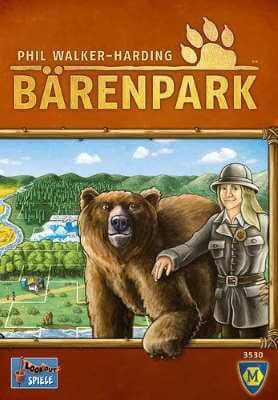
Bärenpark at a Glance
| Game Type Animals Theme, Puzzle, Card Drafting, Grid Coverage, Set Collection, Tile Placement | Play Time 30 - 45 mins | Skill/Complexity (1.8 - 5) Light |
| Age 8+ | Publisher(s) Lookout Spiele, Asmodee | Published 2017 |
| Categories Family | Players 2 - 4 | Cost $39.99 |
| Our Rating 9/10 |
In Bärenpark, players compete to build the best bear park in the most efficient way with structures like exhibits, toilet stalls, rivers, concession stands, and statues. At the end of the game, players gain points for each tile in their bear park with a point value printed on it, statues (which they receive for completely filling a park board), and variable scoring bonuses for fulfilling certain requirements. On a player’s turn, they place one tile from their supply onto their player board, and then, depending on the types of spaces they cover with their newly-placed tile, they have the opportunity to draw new tiles from the main supply and/or add an additional empty board into their park. The game ends once one a player has filled four park boards, and whoever has the most points is the winner.
While Bärenpark has the option to add in variable scoring conditions each game, which are not incredibly complex, these can be omitted for a very easy game to teach new players. Without these scoring conditions, the game is incredibly light yet very puzzly, and turns move very quick. Adding these scoring tiles, however, increases the depth and replayability of the game just enough to keep it fresh and appealing for hobby board gamers.
Without these scoring conditions, the game is incredibly light yet very puzzly, and turns move very quick.
This game would likely be a hit to play with people who enjoy puzzles, or who would appreciate the theme and artwork of the bear exhibits. The game plays with 2-4 players, making it a great game to play in a variety of settings.
13. Lost Cities – Best Casual 2-Player Card Game
There are many occasions when having a good, simple 2-player card game in your collection can be beneficial, whether it’s playing a quick game with a coworker at lunch, or setting up a game to unwind with a significant other after a long day.
Whatever situation you find yourself in, Lost Cities by Reiner Knizia fits this category perfectly and is definitely a good one to bring along in your bag just in the off-chance that the opportunity arises to play a game with one other person.
Lost Cities at a Glance
| Game Type Adventure, Card Drafting, Hand Management | Play Time 60 mins | Skill/Complexity (2 - 5) Light |
| Age 8+ | Publisher(s) Rio Grande Games, Kosmos | Published 2008 |
| Categories Family | Players 2 - 4 | Rules Manual 2 Player Rules PDF 4 Player Rules PDF |
| Our Rating 8.5/10 | Cost $33.99 approx |
Lost Cities puts players in the role of archaeologists attempting to fulfill expeditions at up to five different sites. Each site is represented by a different color, and each card in a player’s hand has a value of 2-10 or has a handshake symbol. On a player’s turn, they may either play a card at a site or discard a card to the discard space at a site. At the end of their turn, they draw a card either from the draw pile or the top card of a discard pile at any site. The game is tricky, however, in its card placement rules and end-of-round scoring requirements. To play a card at a site, it must either be the first card the player has placed there, or of higher value than the previous card. Handshake cards are bonus point multipliers, and must be placed before any numerical-valued cards are placed. At the end of a round, players add up the total point value of all the cards at a given site, and multiply that number by any handshake cards they have at that site. Then, they subtract 20 points as an entry cost for that expedition. In other words, if a player has only placed 10 points worth of cards, they receive -10 points for that expedition. The game continues for three rounds, and then whoever has the most points is the winner.
Being a relatively quick, lightweight card game, and one that is easily teachable to just about anyone, Lost Cities offers a good blend of strategy, tactics, and luck.
Lost Cities offers a good blend of strategy, tactics, and luck.
Players may decide to hold onto cards they don’t need, only because their opponent could use the card; but doing so clogs up their hand from drawing more cards that could benefit them. They must also decide when is a good time to begin a new expedition, and calculate their odds at surpassing 20 points in order to break even. This tension is what makes Lost Cities so much fun, and one of the reasons why it has gained such popularity as a gateway game over the years since it was published in 1999.
14. The Resistance – Best Social Deduction Game
“You’re a spy!” “I’m not a spy! Trust me!” “He’s lying…that’s something only a spy would say.” “Oh, come on, why should you be trusted?” This is just one of the many typical passion-filled conversations around the table in a game of The Resistance, a deduction game by Don Eskridge which features lying, backstabbing, distrust, and paranoia, all in the span of 30 minutes.
As a team of resistance rebels attempt to infiltrate a corrupt government – and determine who in the group are actually spies attempting to sabotage their missions, no one is safe from accusation or name-calling.
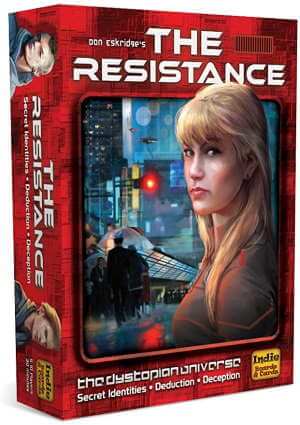
The Resistance at a Glance
| Game Type Bluffing, Card Game, Deduction, Negotiation, Hidden Roles, Memory, Team Based, Spies/Secret Agents, Traitor, Voting | Play Time 30 mins | Skill/Complexity (1.8 - 5) Light |
| Age 13+ | Publisher(s) Indie Boards & Cards and Others | Published 2009 |
| Categories Party | Players 5 - 10 | Cost $29.99 |
| Our Rating 8.3/10 |
At the beginning of a game of The Resistance, players find out secretly whether they are part of the resistance or a government spy, and from that moment on, players who are spies will try to blend in and fulfill their goal of sabotaging three of the five missions that the group will go on over the course of the game. Members of the resistance, on the other hand, are trying to succeed in at least three missions by intentionally selecting members of the group to go on the mission who are trustworthy and loyal to the cause. Each round, a mission leader selects a team of individuals to go on the mission. Then, the group votes to approve or reject that team. If they approve, then each member on the mission secretly succeeds or fails the mission; these succeed/fail cards are shuffled, and then revealed to the group. If just one fail card appears, then the mission has failed (i.e., 1 point for the spies). At that moment, members of the resistance know that there was at least one spy in the mission. But who?
The Resistance is a pure social deduction game, with very few components on the table (the game mostly consists of a mission tracker, voting tokens, and succeed/fail cards).
In this sense, it is not intimidating to people who don’t typically play board games. The game rules are very easy to explain, and the theme of the game quickly comes to life with the social interaction between players.
In this sense, it is not intimidating to people who don’t typically play board games. The game rules are very easy to explain, and the theme of the game quickly comes to life.
This is a game, with the right group of people (5-10), that can create memories for years to come and be a blast. However, this is not necessarily a good game to play with people who do not like direct conflict. Although the personal attacks are usually light-hearted and within the spirit of the game, it’s possible for players who take the game very seriously, or would take the confrontation personally, to get upset or create a negative experience for others at the table.
15. Las Vegas – Best Area Control Game
When you think of an area control game, a dice game featuring a strong push-your-luck element probably isn’t the first one to come to mind. However, Las Vegas has just about one of the easiest area control mechanisms to explain to anyone, with a theme that non-gamers can easily get excited about, and a fun factor that makes it an incredible gateway game.
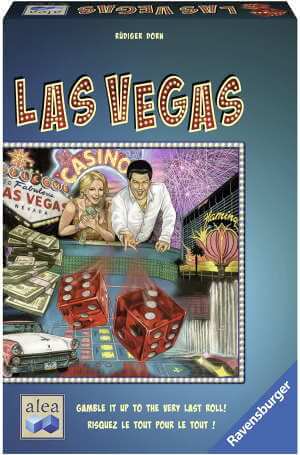
Las Vegas at a Glance
| Game Type Casino Theme, Area Majority, Dice Rolling | Play Time 30 mins | Skill/Complexity (1.3 - 5) Light |
| Age 8+ | Publisher(s) Ravensburger, Alea | Published 2012 |
| Categories Strategy / Family | Players 2 - 5 (4 is best ) | Cost approx $29.99 |
| Our Rating 8.8/10 |
Las Vegas, designed by Rüdiger Dorn, is a game in which players try to bring home the most cash from casinos. Each round, money cards are revealed at each of the six casinos until they all have at least $50,000 worth of money for players to win. Players will take turns assigning dice to casinos, and then whoever has the most dice at a given casino will win the highest-value money card. The player in second place brings home the second-highest money card, and so on. In case of a tie, the tied players’ dice are discarded, meaning that two players who have placed four dice each can lose to a player who has only placed one. On a player’s turn first turn in a round, they roll eight dice of their color, and then choose all the dice of one value to assign to the corresponding casino (each casino has a die value printed). On their next turn, they roll the remaining dice in their pool, and continue playing this way on future turns until they have no dice left. Once all players are out of dice, the round ends and each casino is evaluated to determine a winner. At the end of the game, whoever has the most money wins.
There are many reasons why Las Vegas is an ideal gateway game, but the most prominent aspects of the game that makes it well-suited for non-gamers are its theme, quick turns, blend of luck and strategy, and exciting (stand up and cheer) moments in the game when a player rolls just right to bring home a big prize.
Aspects of the game that makes it well-suited for non-gamers are its theme, quick turns, blend of luck and strategy, and exciting (stand up and cheer) moments in the game
Furthermore, it introduces non-gamers to the concept of area control – whoever has the most dice at a casino wins the biggest prize, but sometimes coming in second place is also a good strategy. While luck plays a factor in this game, there is still some depth and strategy in terms of whether to put a lot of dice on a couple casinos or spread dice thinly on the board to try and get some second or third-place prizes.
That’s about it for the Best Gateway Board Games – Top 15 for New Gamers category for now!
